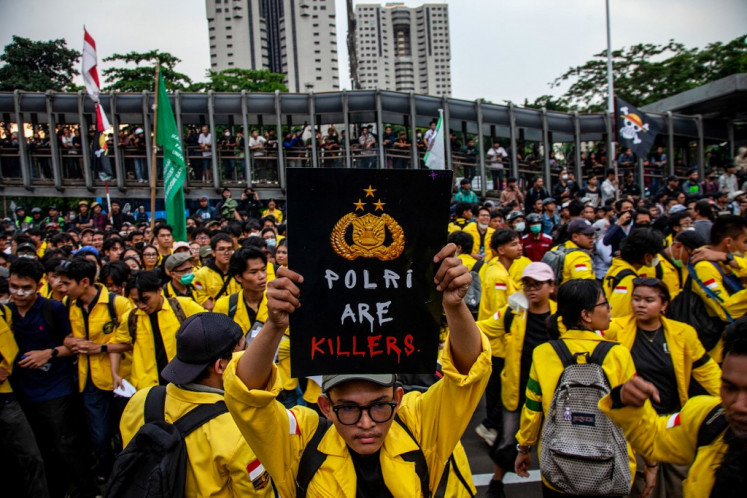Popular Reads
Top Results
Can't find what you're looking for?
View all search resultsPopular Reads
Top Results
Can't find what you're looking for?
View all search resultsForest fires not disastrous but concerns remain
When the news of raging forest and land fires across the country broke out earlier this year, concerns were raised that they could be the end for Indonesia’s remaining rainforests as the massive flames engulfed the country’s vast green belt inch by inch
Change text size
Gift Premium Articles
to Anyone
When the news of raging forest and land fires across the country broke out earlier this year, concerns were raised that they could be the end for Indonesia’s remaining rainforests as the massive flames engulfed the country’s vast green belt inch by inch.
However, a recent report by an environment research group, the Center for International Forestry Research (CIFOR), showed that Indonesia might still have a chance to hold onto its oxygen sources as this year’s wildfires mostly burned idle land and former forests rather than intact rainforests.
Alarm bells alerting of ecological impacts still rang as this year’s fire season blazed through peatland and aged forests and led to the release of millions of tons of greenhouse gasses into the atmosphere.
CIFOR’s report, issued on Monday, highlighted an analysis of satellite imagery of burned land across the archipelago from between Jan. 1 and Oct. 31.
The group’s scientists analyzed time-series images taken by the Sentinel-2 satellite using the Google Earth Engine to look for how much land had burned and what type of land cover had gone up in flames.
The satellite images showed that 76 percent of the burned land in 2019 was classified as lahan terlantar (idle lands). The areas were forests several years ago, but cycles of repeated burns have converted them into unproductive, degraded scrubland.
“While there has been much speculation in the news that the heavy fire season has taken a toll on the country’s remaining rainforests, there was no hard evidence to support that notion,” said David Gaveau, a landscape ecologist and research associate at CIFOR, wrote in the report.
The satellite assessment estimated that 1.64 million hectares burned over the period across seven Indonesian provinces, including 670,000 ha — 41 percent of the total burned area — in peatland.
Fires were recorded in Central Kalimantan, West Kalimantan, South Kalimantan, as well as in Jambi, South Sumatra and in Papua.
Recent research found that the peatland areas in Indonesia are mostly located in those provinces.
“There has been much speculation in the news that Indonesian fires are ignited by land clearing activities to establish plantations. Clearing land for this purpose only partly describes the situation. Uncontrolled fires easily propagate well beyond the intended area of burning because of large areas of flammable idle and degraded scrubland, the legacy of past deforestation,” the CIFOR statement said.
Although this year’s wildfires did not burn much of Indonesia’s rainforest, CIFOR reported it was the second worst forest and land fire season in Indonesia in terms of total area burned. It said the worst was in 2015.
The group recorded 2.6 million ha burned in 2015, leading to the emission of 1.2 billion tons of CO2 equivalent, representing half of the country’s total emissions that year.
CIFOR argued the fires had still caused irreparable damage to peat-swamp forests, bringing consequences to the ecosystems. It also caused substantial damage to important wildlife habitats, such as the tiger habitat in Berbak National Park in Jambi and the orangutan’s in Sungai Putri, West Kalimantan.
In regards to the emissions, this year’s wildfires had also emitted large amounts of greenhouse gasses — double the emissions emitted by the fire in the Amazon basin forest in Brazil.
According to the Copernicus Atmosphere Monitoring Service (CAMS), the total estimated equivalent CO2 emissions from fires in Indonesia from Jan. 1 to Nov. 30 was 660 megatons, while the fires in Brazilian emitted 366 megatons of CO2 equivalent.
“The amount of CO2 emitted is more an indicator of the extent and scale of the fire activity,” CAMS scientist Mark Parrington told The Jakarta Post recently.
Climate scientists argued that this year’s forest and land fires had been worsened by the prolonged dry season occurring across the archipelago throughout the year, which was likely to have been caused by a climate phenomenon called the positive Indian Ocean Dipole.
According to the Australian Bureau of Meteorology, the phenomenon is defined by the difference in sea surface temperature between two areas in the Indian Ocean. It affects the climate of countries surrounding the Indian Ocean Basin, and is a significant contributor to rainfall variability in the region.
“The event is thought to have contributed to drier conditions in Sumatra and Southern Kalimantan through September and could explain the comparable daily emissions to the same period [...] in 2015,” Parrington said.
Such findings had strengthened the case for mass restoration of degraded peatland in order to reduce the risk of future wildfires, as well as to prevent more greenhouse gasses from being emitted into the atmosphere. One way to achieve this is through a paradigm shift, according to CIFOR’s report.
“Only by considering nature as part of a vital, a green infrastructure that must be rebuilt and maintained with adequate investment in tandem with other infrastructure, can we begin to see significant changes,” the report stated.










